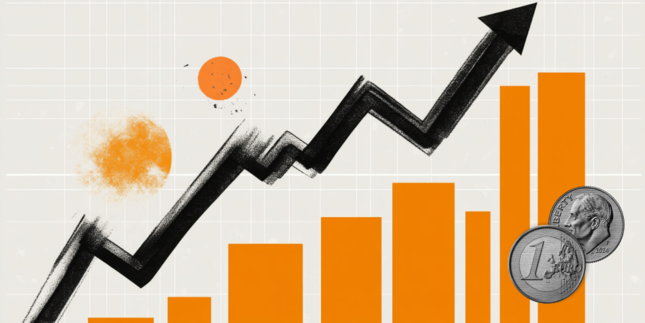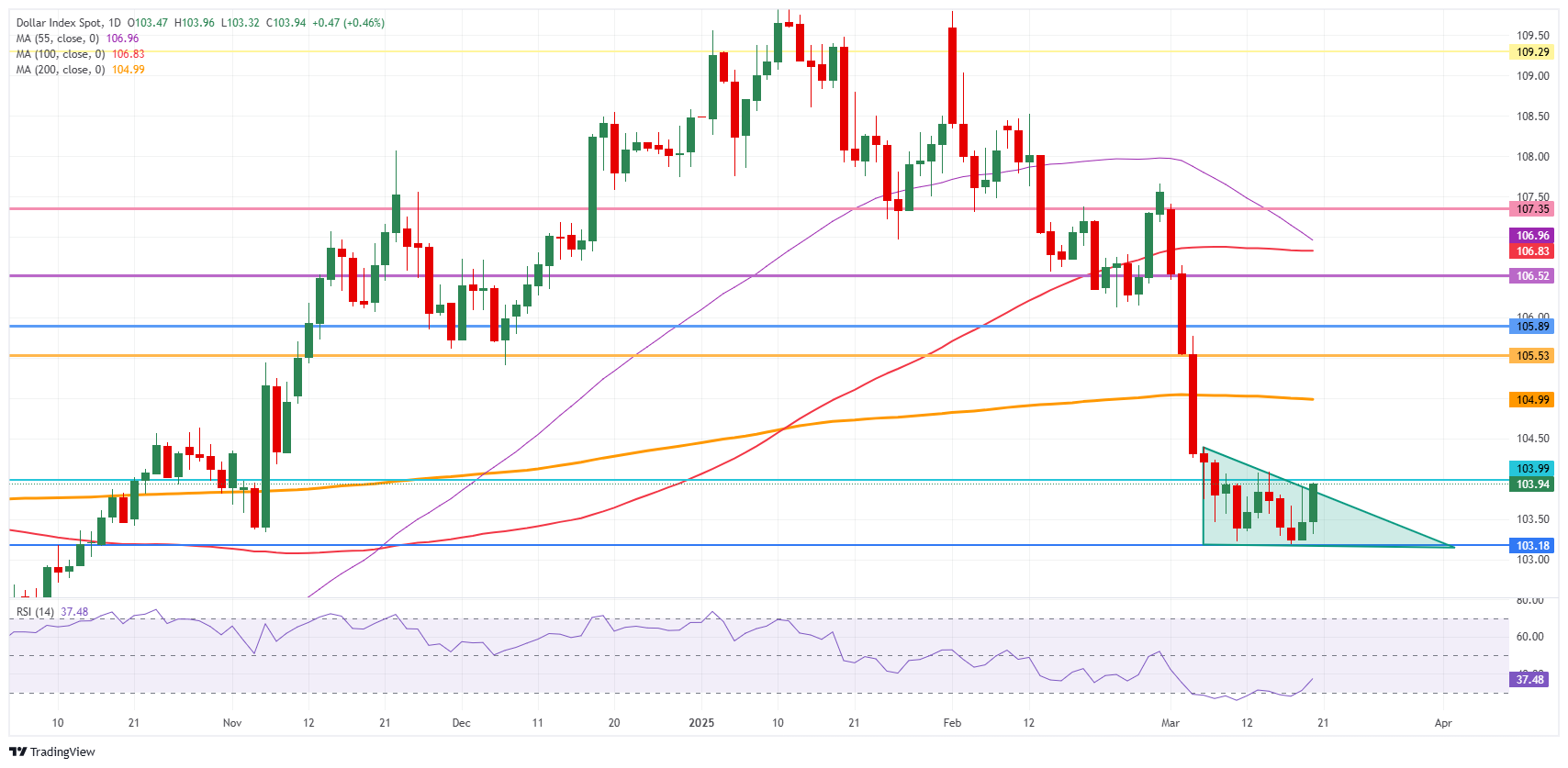- The US Dollar appreciates throughout the day and ekes out big gains.
- Traders see the Fed confirming market projections on cutting cycle for 2025.
- The US Dollar Index breaks out of its 103.00 - 104.00 range for the first time in weeks.
The US Dollar Index (DXY), which tracks the performance of the US Dollar (USD) against six major currencies, rallies above 104.00 on Thursday after the weekly jobcless claims data. Borrowing costs were kept unchanged overnight by the Federal Reserve (Fed), and projected two interest rate cuts for 2025. During Wednesday’s Fed meeting, Chairman Jerome Powell said that any tariff-driven bump in inflation will be “transitory.” However, he added later that it will be very challenging to say with confidence how much inflation stems from tariffs versus other factors. He also said recession odds have moved up, though are not high, Bloomberg reports.
Meanwhile US yields are plunging lower with investors heading into US bonds. The prospects of yields set to decline once the Fed starts cutting, sees a flight into the safe haven asset. That together with the geopolitical uncertainty as clearly a quick ceasefire for Ukraine is out of the cards and geopolitical tensions are heightened in Turkey and Gaza, makes sense that the safe haven US bonds are favoured again.
Daily digest market movers: Bonds push US yields lower
- At 12:30 GMT, the most important data for this Thursday was released:
- US Initial Jobless Claims ticekd up to 223,000, coming from 221,000. The US Continuing Jobless Claims came in at 1,892 million against 1,859million last week.
- The Philadelphia Fed Manufacturing Survey for March fell to 12.5, better than the expected 8.5 and from the previous 18.1.
- At 14:00 GMT, US Existing Home Sales month-on-month for February will be released. Expectations are for a contraction to 3.95 million compared to 4.08 million the previous month.
- Equities are struggling with European indices facing big profit-taking. The German Dax is down over 1%. US equities are trying to brush off the negative tone and turn higher on the day.
- According to the CME Fedwatch Tool, the probability of interest rates remaining at the current range of 4.25%-4.50% in May’s meeting is at 80.5%. For June, the odds for borrowing costs being lower stand at 71.1%.
- The US 10-year yield trades around 4.22%, heading back to its five-month low of 4.10% printed on March 4.
US Dollar Index Technical Analysis: Keep calm
The US Dollar Index (DXY) is trying to break out of a short-term technical descending triangle pattern. The tilted side of a triangle should act as strong resistance while the flat base of the triangle at 103.18 should act as strong support. Normally, the textbook logic is that sellers will build up positions alongside the tilted descending trend line in order to break through that flat base, which will result in more downturn.
The fact that currently the DXY is trying to break out of that pattern could be a sign for a turnaround, though heavy resistance is awaiting just around the corner at 104.00.
If bulls can avoid a technical rejection at 104.00, a large sprint higher towards the 105.00 round level could happen, with the 200-day Simple Moving Average (SMA) converging at that point and reinforcing this area as a strong resistance. Once broken through that zone, a string of pivotal levels, such as 105.53 and 105.89, could limit the upward momentum.
On the downside, the 103.00 round level could be considered a bearish target in case US yields roll off on deteriorating US data, with even 101.90 on the table if markets further capitulate on their long-term US Dollar holdings.
US Dollar Index: Daily Chart
Fed FAQs
Monetary policy in the US is shaped by the Federal Reserve (Fed). The Fed has two mandates: to achieve price stability and foster full employment. Its primary tool to achieve these goals is by adjusting interest rates. When prices are rising too quickly and inflation is above the Fed’s 2% target, it raises interest rates, increasing borrowing costs throughout the economy. This results in a stronger US Dollar (USD) as it makes the US a more attractive place for international investors to park their money. When inflation falls below 2% or the Unemployment Rate is too high, the Fed may lower interest rates to encourage borrowing, which weighs on the Greenback.
The Federal Reserve (Fed) holds eight policy meetings a year, where the Federal Open Market Committee (FOMC) assesses economic conditions and makes monetary policy decisions. The FOMC is attended by twelve Fed officials – the seven members of the Board of Governors, the president of the Federal Reserve Bank of New York, and four of the remaining eleven regional Reserve Bank presidents, who serve one-year terms on a rotating basis.
In extreme situations, the Federal Reserve may resort to a policy named Quantitative Easing (QE). QE is the process by which the Fed substantially increases the flow of credit in a stuck financial system. It is a non-standard policy measure used during crises or when inflation is extremely low. It was the Fed’s weapon of choice during the Great Financial Crisis in 2008. It involves the Fed printing more Dollars and using them to buy high grade bonds from financial institutions. QE usually weakens the US Dollar.
Quantitative tightening (QT) is the reverse process of QE, whereby the Federal Reserve stops buying bonds from financial institutions and does not reinvest the principal from the bonds it holds maturing, to purchase new bonds. It is usually positive for the value of the US Dollar.
Information on these pages contains forward-looking statements that involve risks and uncertainties. Markets and instruments profiled on this page are for informational purposes only and should not in any way come across as a recommendation to buy or sell in these assets. You should do your own thorough research before making any investment decisions. FXStreet does not in any way guarantee that this information is free from mistakes, errors, or material misstatements. It also does not guarantee that this information is of a timely nature. Investing in Open Markets involves a great deal of risk, including the loss of all or a portion of your investment, as well as emotional distress. All risks, losses and costs associated with investing, including total loss of principal, are your responsibility. The views and opinions expressed in this article are those of the authors and do not necessarily reflect the official policy or position of FXStreet nor its advertisers. The author will not be held responsible for information that is found at the end of links posted on this page.
If not otherwise explicitly mentioned in the body of the article, at the time of writing, the author has no position in any stock mentioned in this article and no business relationship with any company mentioned. The author has not received compensation for writing this article, other than from FXStreet.
FXStreet and the author do not provide personalized recommendations. The author makes no representations as to the accuracy, completeness, or suitability of this information. FXStreet and the author will not be liable for any errors, omissions or any losses, injuries or damages arising from this information and its display or use. Errors and omissions excepted.
The author and FXStreet are not registered investment advisors and nothing in this article is intended to be investment advice.
Recommended content
Editors’ Picks

Gold pulls back from record highs of $3,500
Gold price retreats from $3,500, new all-time high, in the European session on Tuesday as buyers pause for a breather amid overbought conditions on short-term charts. Any meaningful corrective downfall, however, still seems elusive on persistent US Dollar downtrend.

EUR/USD battles 1.1500 as US Dollar looks to stabilize
EUR/USD is battling 1.1500 in the European session on Tuesday. The pair loses traction as the US Dollar finds its feet even as investors remain wary of the US financial stability amid Trump's attacks on Fed Chair Powell. Speeches from ECB and Fed officials are on the radar.

GBP/USD reverses below 1.3400 as US Dollar pauses decline
GBP/USD is back below the 1.3400 mark in the European trading hours on Tuesday, feeling the heat from the pause in the US Dollar decline. But the pair's further dowside appears limited as fears of a US economic slowdown and concerns about the Fed's independence will continue to remain a headwind for the Greenback.

3% of Bitcoin supply in control of firms with BTC on balance sheets: The good, bad and ugly
Bitcoin disappointed traders with lackluster performance in 2025, hitting the $100,000 milestone and consolidating under the milestone thereafter. Bitcoin rallied past $88,000 early on Monday, the dominant token eyes the $90,000 level.

Five fundamentals for the week: Traders confront the trade war, important surveys, key Fed speech Premium
Will the US strike a trade deal with Japan? That would be positive progress. However, recent developments are not that positive, and there's only one certainty: headlines will dominate markets. Fresh US economic data is also of interest.

The Best brokers to trade EUR/USD
SPONSORED Discover the top brokers for trading EUR/USD in 2025. Our list features brokers with competitive spreads, fast execution, and powerful platforms. Whether you're a beginner or an expert, find the right partner to navigate the dynamic Forex market.




